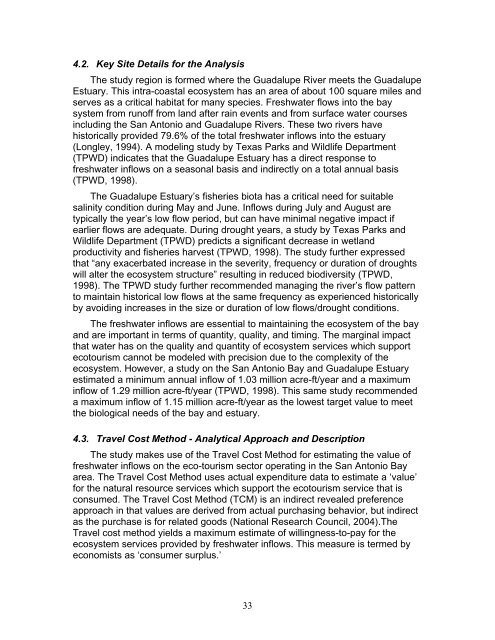The Economic Value of Water and Ecosystem Preservation
The Economic Value of Water and Ecosystem Preservation
The Economic Value of Water and Ecosystem Preservation
Create successful ePaper yourself
Turn your PDF publications into a flip-book with our unique Google optimized e-Paper software.
4.2. Key Site Details for the Analysis<br />
<strong>The</strong> study region is formed where the Guadalupe River meets the Guadalupe<br />
Estuary. This intra-coastal ecosystem has an area <strong>of</strong> about 100 square miles <strong>and</strong><br />
serves as a critical habitat for many species. Freshwater flows into the bay<br />
system from run<strong>of</strong>f from l<strong>and</strong> after rain events <strong>and</strong> from surface water courses<br />
including the San Antonio <strong>and</strong> Guadalupe Rivers. <strong>The</strong>se two rivers have<br />
historically provided 79.6% <strong>of</strong> the total freshwater inflows into the estuary<br />
(Longley, 1994). A modeling study by Texas Parks <strong>and</strong> Wildlife Department<br />
(TPWD) indicates that the Guadalupe Estuary has a direct response to<br />
freshwater inflows on a seasonal basis <strong>and</strong> indirectly on a total annual basis<br />
(TPWD, 1998).<br />
<strong>The</strong> Guadalupe Estuary’s fisheries biota has a critical need for suitable<br />
salinity condition during May <strong>and</strong> June. Inflows during July <strong>and</strong> August are<br />
typically the year’s low flow period, but can have minimal negative impact if<br />
earlier flows are adequate. During drought years, a study by Texas Parks <strong>and</strong><br />
Wildlife Department (TPWD) predicts a significant decrease in wetl<strong>and</strong><br />
productivity <strong>and</strong> fisheries harvest (TPWD, 1998). <strong>The</strong> study further expressed<br />
that “any exacerbated increase in the severity, frequency or duration <strong>of</strong> droughts<br />
will alter the ecosystem structure” resulting in reduced biodiversity (TPWD,<br />
1998). <strong>The</strong> TPWD study further recommended managing the river’s flow pattern<br />
to maintain historical low flows at the same frequency as experienced historically<br />
by avoiding increases in the size or duration <strong>of</strong> low flows/drought conditions.<br />
<strong>The</strong> freshwater inflows are essential to maintaining the ecosystem <strong>of</strong> the bay<br />
<strong>and</strong> are important in terms <strong>of</strong> quantity, quality, <strong>and</strong> timing. <strong>The</strong> marginal impact<br />
that water has on the quality <strong>and</strong> quantity <strong>of</strong> ecosystem services which support<br />
ecotourism cannot be modeled with precision due to the complexity <strong>of</strong> the<br />
ecosystem. However, a study on the San Antonio Bay <strong>and</strong> Guadalupe Estuary<br />
estimated a minimum annual inflow <strong>of</strong> 1.03 million acre-ft/year <strong>and</strong> a maximum<br />
inflow <strong>of</strong> 1.29 million acre-ft/year (TPWD, 1998). This same study recommended<br />
a maximum inflow <strong>of</strong> 1.15 million acre-ft/year as the lowest target value to meet<br />
the biological needs <strong>of</strong> the bay <strong>and</strong> estuary.<br />
4.3. Travel Cost Method - Analytical Approach <strong>and</strong> Description<br />
<strong>The</strong> study makes use <strong>of</strong> the Travel Cost Method for estimating the value <strong>of</strong><br />
freshwater inflows on the eco-tourism sector operating in the San Antonio Bay<br />
area. <strong>The</strong> Travel Cost Method uses actual expenditure data to estimate a ‘value’<br />
for the natural resource services which support the ecotourism service that is<br />
consumed. <strong>The</strong> Travel Cost Method (TCM) is an indirect revealed preference<br />
approach in that values are derived from actual purchasing behavior, but indirect<br />
as the purchase is for related goods (National Research Council, 2004).<strong>The</strong><br />
Travel cost method yields a maximum estimate <strong>of</strong> willingness-to-pay for the<br />
ecosystem services provided by freshwater inflows. This measure is termed by<br />
economists as ‘consumer surplus.’<br />
33
















